It’s easy to pick out the plants you love, but learning which ones will thrive together in the landscape and look fabulous doing so takes some practice. We’ve gathered ten of our best landscape combinations here to inspire you as your plan out your garden for the season, whether you are adding a whole new garden bed or renovating one you already have. Pairings for full sun, part shade and everything in between are included so you can find just the right fit for your conditions. Let’s get started. It’s time to plant!
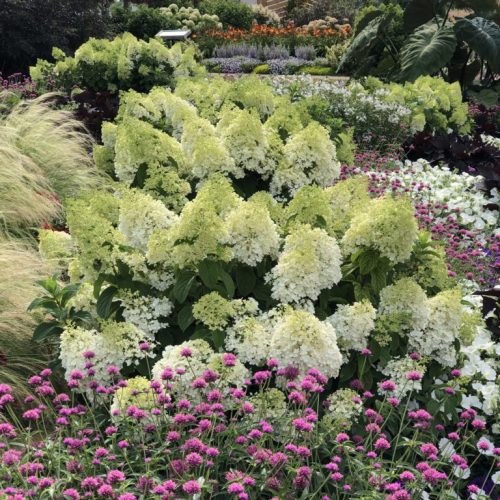
Combination: Bobo® panicle hydrangeas + TruffulaTM Pink globe amaranth
Where to Grow: Full sun to light shade, average well-drained soil
Hardiness: Bobo, zone 3-8. Truffula Pink, annual.
Why It Works: This gorgeous layered landscape includes a broad mix of textures, from big and bold hydrangea flowers to the cotton ball-shaped blossoms of the globe amaranth and a soft sweep of Stipa grass to the side. Standing 2’ tall, Truffula Pink is just the right scale for planting in front of the 4’ tall Bobo hydrangeas—not too big and not too short. It provides color before the hydrangeas come into bloom in midsummer. As an added bonus, everything you see here can be used as a cut flower for both fresh and dried bouquets.
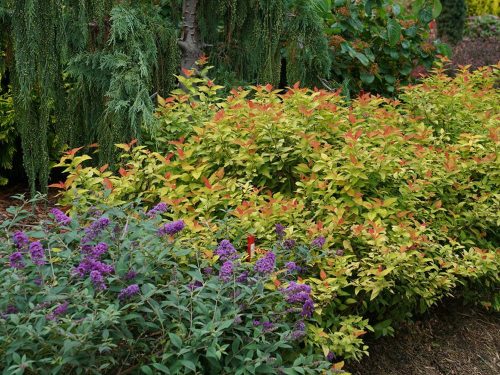
Combination: Lo & Behold® ‘Blue Chip’ butterfly bush + Double Play® Candy Corn® spirea
Where to Grow: Full sun, average well-drained soil
Hardiness: Blue Chip, zone 5-9. Candy Corn, zone 4-8.
Why It Works: As you can see in this photo and a few other pairings on this page, any shade of yellow + purple is always a sure bet. These striking contrasting colors will catch your eye every time you pass by. Since this butterfly bush blooms non-stop from summer through fall without going to seed, you’ll get to enjoy the colorful pairing all season without needing to deadhead the spent flowers. Bright pinky-purple blossoms top the spirea in early summer, providing food for pollinators before the butterfly bush begins its show.
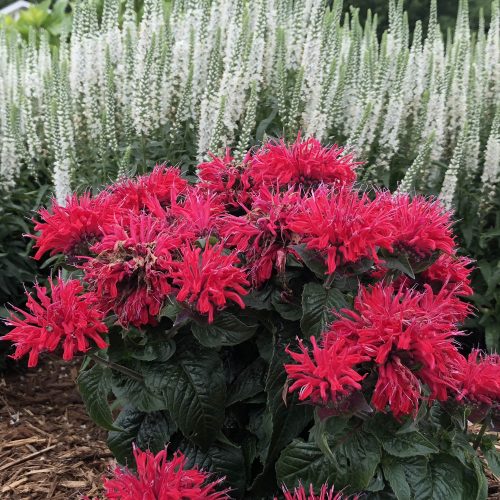
Combination: ‘Pardon My Cerise’ bee balm + Magic Show® ‘White Wands’ spike speedwell
Where to Grow: Full sun to part shade, average to moist soil
Hardiness: ‘Pardon My Cerise’, zone 4-8. ‘White Wands’, zone 4-8.
Why It Works: This hardy perennial landscape combination lights up the landscape in mid to late summer when it comes into full bloom. It is a pollinator’s paradise since both perennials are favorites of bumblebees and honeybees but are generally not favored by deer. They thrive in the same growing conditions and are very similar in size, maturing to about 14-18” tall and wide. ‘Pardon My Cerise’ is a clump-forming bee balm that won’t spread and overtake its neighbors. After a few years, both can be divided and transplanted to repeat the pairing in other places in your garden.
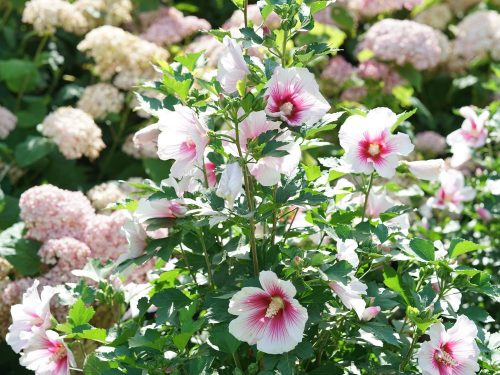
Combination: Paraplu Pink Ink® rose of Sharon + Incrediball® Blush smooth hydrangea
Where to Grow: Full sun to light shade, average well-drained soil
Hardiness: Paraplu Pink Ink, zone 5-9. Incrediball Blush, zone 3-8.
Why It Works: This pairing is the ultimate pretty in pink scenario. We’re enamored with the gorgeous tropical-looking flowers of this hardy rose of Sharon which are much larger than most, with intricate eyelash-like striping emanating from the centers. Since it grows several feet taller than the hydrangea, they’ll be in clear view when they are at their peak from midsummer to fall. The fluffy blush pink mophead blossoms of Incrediball Blush appear in midsummer and rebloom throughout the season. Plant them on each side of the rose of Sharon to fill your landscape with pink blooms for months.
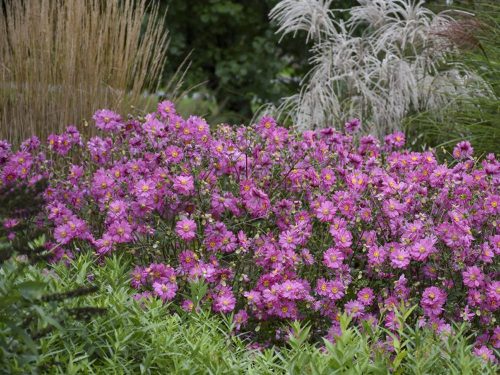
Combination: Fall in LoveTM ‘Sweetly’ Japanese anemone, ‘Karl Foerster’ Calamagrostis, ‘Encore’ Miscanthus
Where to Grow: Full sun to part sun, average to moist soil
Hardiness: Fall in LoveTM ‘Sweetly’, zone 4-8. ‘Karl Foerster’, zone 5-8. ‘Encore’, zone 5-9.
Why It Works: An absolute delight in late summer and fall, Japanese anemones and ornamental grasses always make a dazzling landscape combination. We love how this extra-floriferous variety of anemone forms a dense mound of color to contrast with the feathery plumes of the Miscanthus. Long before either of them comes into bloom, ‘Karl Foerster’ grass sends up its wheatlike plumes that persist through fall. This deer resistant perennial pairing will thrive in landscapes that see a minimum of 4 to 6 hours of sun with most of that coming in the afternoon.
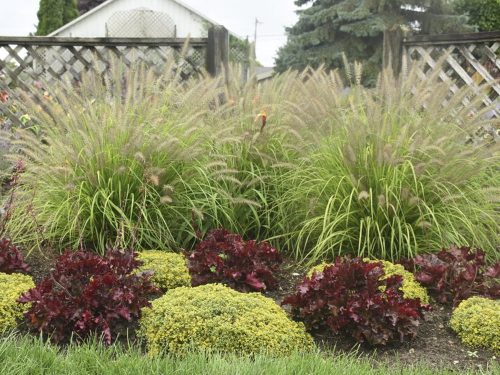
Combination: ‘Lemon Squeeze’ hardy fountain grass + Dolce® ‘Cherry Truffles’ coral bells + ‘Yellow Brick Road’ stonecrop
Where to Grow: Full sun, average well-drained soil
Hardiness: ‘Lemon Squeeze’, zone 5-9. ‘Cherry Truffles’, zone 4-9. ‘Yellow Brick Road’, zone 3-9.
Why It Works: This whimsical pairing brings bright yellow and deep burgundy red color to sunny landscapes all season long thanks to the fantastic foliage of the ornamental grass and coral bells. In mid to late summer, the sedum joins in the fun when it transforms into a golden yellow carpet of blooms that bring in the honeybees. If coral bells need more shade in your climate or if you’d prefer more flowers, try substituting ‘Cherry Truffles for ‘Midnight Masquerade’ penstemon. It will give you a similar look with the added bonus of lavender purple flowers in early summer.
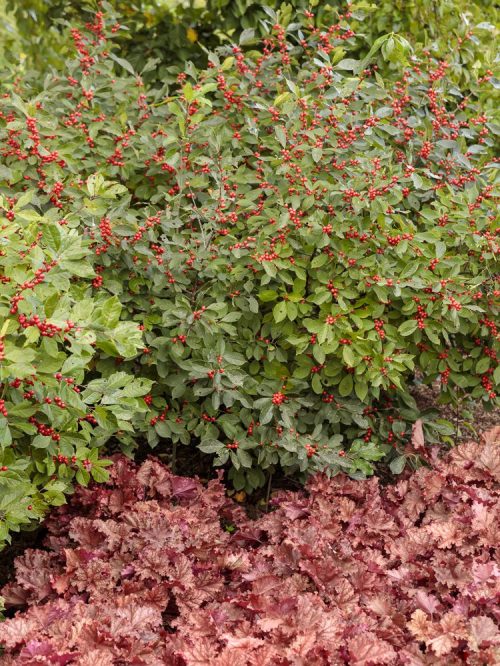
Combination: Berry Heavy® winterberry holly + Primo® ‘Peachberry Ice’ coral bells
Where to Grow: Full sun to part shade, average to moist well-drained soil
Hardiness: Berry Heavy, zone 3-9. Peachberry Ice, zone 4-9.
Why It Works: Winterberry holly is guaranteed to be one of the most colorful plants in your garden from late fall through winter when it is loaded with scarlet red fruit. But from spring through summer, it tends to go incognito and blend into the background. That’s why pairing it with something that has all-season color like coral bells is a good idea. Its colorful foliage will play center stage for most of the growing season until the winterberries appear. Once the leaves fall from this deciduous holly, you’ll be left with its red fruit and the deep peach tones of the coral bells—a welcome warm-toned pairing for a cold time of year.
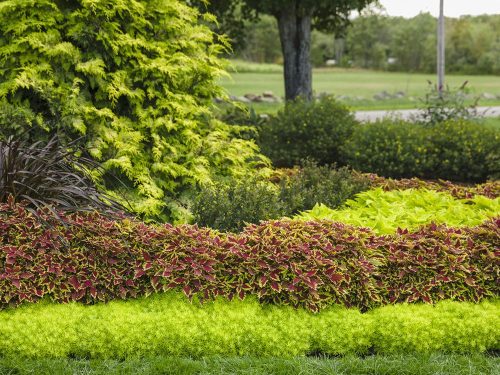
Combination: Soft Serve® Gold false cypress, Vertigo® fountain grass, ColorBlaze® Apple Brandy® and Lime Time® coleus, Lemon Coral® sedum
Where to Grow: Full sun to part shade, average soil
Hardiness: Soft Serve® Gold, zone 4-8. Lemon Coral, zone 7-11. All others, annuals.
Why It Works: This perfectly choreographed combination brings layers of sumptuous color and texture to the landscape from spring through fall. Starting with the 6-10’ tall golden evergreen as a focal point, we work our way down in size until we reach the low growing carpet of succulent chartreuse sedum. If you pay close attention to the sizes of the plants you choose for your landscape, you too can create a layered planting like this that is attractive from every angle. As an added bonus, this landscape combination is deer resistant.
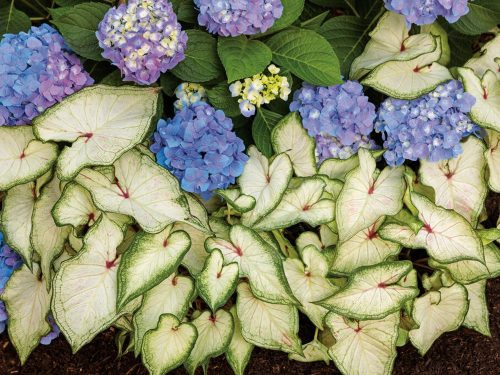
Combination: Let’s Dance® Blue Jangles® bigleaf hydrangea + Heart to Heart® ‘White Star’ caladium
Where to Grow: Full sun to part shade, average to moist soil
Hardiness: Blue Jangles, zone 5-9. Caladiums, annual.
Why It Works: Blue and white is a timeless combination for everything from fashion to home décor and garden design. It’s easy to achieve in this landscape pairing of Blue Jangles and ‘White Star’ caladiums, especially if your soil is naturally acidic. That brings out the bright blue tones of the hydrangea’s flowers. (Read more about that here.)
If you live in zones 5 or 6, you’ll be able to grow this pairing in full sun, but if you live someplace warmer, you’ll need to provide some afternoon shade to prevent leaf and flower scorch. Using caladiums as an underplanting for hydrangeas not only looks pretty—they act like a living mulch to provide shade and keep the hydrangeas’ roots cool.
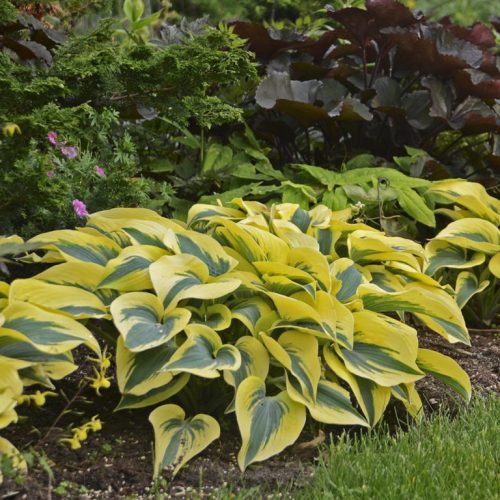
Combination: Shadowland ‘Autumn Frost’ hosta + ‘Britt-Marie Crawford’ bigleaf ligularia
Where to Grow: Part shade, average to moist soil
Hardiness: ‘Autumn Frost’, zone 3-9. ‘Britt-Marie Crawford’, zone 4-9.
Why It Works: There’s no need to wait for flowers to make this fabulous foliage pairing work.
Sharp color contrast is what’s so eye-catching here. The brilliant yellow and blue spring variegation of the hosta is especially striking when planted against a backdrop of deep purple to near-black ligularia foliage. The 3-4’ tall ligularia makes a strong focal point in the landscape all season as it complements anything it is planted with. You could also try adding in a few Japanese painted ferns and Jacob’s ladder to bring more fine texture to this grouping. Who says shade gardens can’t be colorful, too?
Want to learn more about landscape design?
